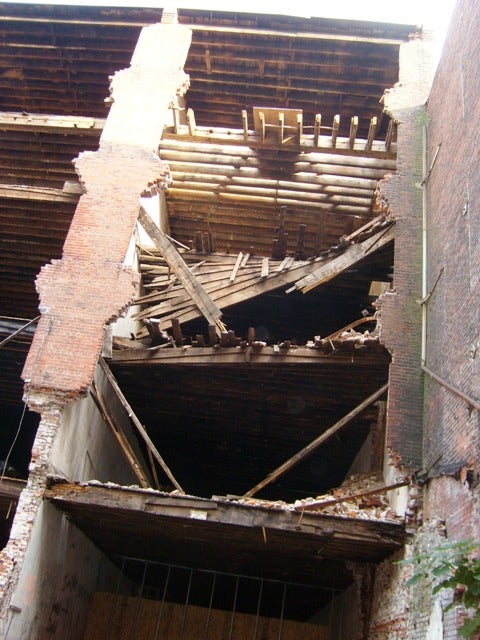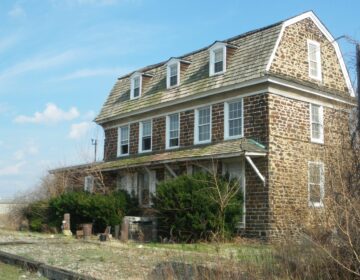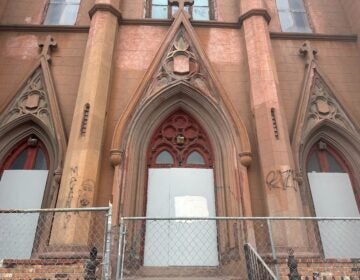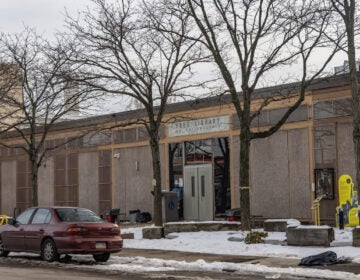On the brink of extinction?

Rear portion of Girard Warehouses
Oct. 8
By Alan Jaffe
and Matt Blanchard
For PlanPhilly
The historic Girard Estate Warehouse buildings in Old City could be in danger of collapse, apparently the result of years of neglect and the actions of a developer.
“They are in dangerous condition, and we’re furious,” said Rich Thom, an architect who chairs the developments committee of the Old City Civic Association. The association is working with the city to find out what emergency steps can be taken to shore up the buildings.
Thom said members of the association are also concerned that there may be an attempt to have the property declared imminently dangerous, resulting in court permission to demolish the buildings.
The New York-based developer, BRP Development, which has planned to transform the property into the Old City Mercantile Condominiums, did not return requests for comment Friday or Monday.
The buildings at 20-30 Front Street were erected between 1828 and 1834 by the estate of Stephen Girard, and may have been built by the shipping magnate himself, said City Planning Commission member Laura Spina. They were listed as “significant” structures on the Philadelphia Historic Register in 1977, and they are also on National Register of Historic Places and have been documented by the Historical American Building Survey, she said.
“That block is such an icon. It shows up when you look at many old etchings of the city,” said Liz Blazevich, advocacy associate at the Preservation Alliance of Greater Philadelphia, which had worked with BRP Development when it submitted plans for the luxury condo project to the city Historical Commission.
The buildings are important to the waterfront’s history, Thom said. “They are the last intact Girard warehouses that faced the waterfront. They go back to him personally and his family,” and goods imported by the Girards were brought from the ships docked on the Delaware and stored in those buildings.
In recent decades, the property was under the control of the Board of City Trusts, Thom said. “That board refused to sell the properties or fix them up. We had a city-run agency letting them deteriorate.”
The Old City Civic Association protested and wrote letters to the board, “but they wouldn’t listen,” Thom said.
About five years ago the property was sold to Philadelphia developer Dan Katz, Blazevich said.
But when Katz proposed a 10-story tower at the site, the Old City group rejected it.
Katz then sold the property to Tom Stafford, who is still believed to be the deed holder, but the property is owned by BRP.
BRP’s plan for the site was “great,” in keeping with height and profile of surrounding structures, Blazevich said.
The Old City Civic Association and the Historical Commission were “thrilled” with the BRP proposal, Thom said. “We had a wonderful presentation from these guys, and the OCCA fully embraced it.” His committee, however, remained “skeptical.”
“We didn’t think they understood the condition of these buildings – the 50 years of neglect, the water coming in, the floors deteriorating…”
Construction began last spring, Thom said. In late May, two rear walls fell in a “precipitous collapse. They’re in that condition now. The ownership went back to the Historical Commission in early June and said they’d restore it.” The commission signed off on emergency steps the developers requested, Thom said.
Representatives of the Historical Commission were not available for comment Friday. Commissioners in the Department of Licenses and Inspections also were not available for comment.
Over the summer, Thom said very little work was going on at the site, and no stabilization measures were put in place, except in window openings. The floor structure is still exposed in the rear of the building and there have been no steps to shore them up, Thom said. “That can snowball into more collapses. The floor structure is just hanging there – it’s a holy mess.”
A visit to the site on Monday confirmed there was heavy structural damage to the rear end of the warehouses; many lintels on the Church Street side and back of the buildings were missing; old bricks were strewn about the site and sidewalks; and sections of the site that posed a safety hazard were not cordoned off.
Thom said he does not believe the developer understood what could happen at the aging structure, nor did the developer foresee the slowing of the condo market. He is worried that the developer may now seek the demolition of the property.
“There’s nothing more valuable in a historic district than vacant, empty property surrounded by other historic buildings,” he said.
Ted Newbold, a neighbor of the Girard property, said the developer and officials from L&I and the Historical Commission had visited the site and secured front windows and doors and took measures to keep bricks from falling.
Blazevich, of the Preservation Alliance, said no one is working on the site now.
Thom said the rental fencing that surrounded the property has been taken down and no one has been working at the site in weeks.
Joe Martz, who became executive director of the Girard Estate nine weeks ago, after serving as Gov. Rendell’s Secretary of Administration, said Friday he was not familiar with the situation at the warehouse property. He said he would look into it and have comment next week.
The Old City Mercantile Condominiums project appears on the BRP website, www.brpdev.com, which says the condos will be available in winter 2008.
WHYY is your source for fact-based, in-depth journalism and information. As a nonprofit organization, we rely on financial support from readers like you. Please give today.






